A Historical Twist on Long-Range Wireless: Building a 103 km Multi-Hop Network Replicating Claude Chappe’s Telegraph
Abstract
1. Introduction
- We provide a historical overview of the development of the Chappe Telegraph.
- We describe how we translate that concept to today’s low-power wireless technology.
- We demonstrate a wireless network reaching 103 km, and discuss the challenges and the opportunities for long-range multi-hop mesh networks.
2. Claude Chappe’s 1794 Telegraph
3. Survey of Current IoT Technologies
3.1. Single-Hop IoT Networks
3.2. Multi-Hop IoT Networks
4. Experimental Setup
4.1. Network Configuration
4.2. Network Planning
5. A 103-km Wireless Network
6. Conclusions
Author Contributions
Funding
Institutional Review Board Statement
Informed Consent Statement
Data Availability Statement
Conflicts of Interest
References
- Civerchia, F.; Bocchino, S.; Salvadori, C.; Rossi, E.; Maggiani, L.; Petracca, M. Industrial Internet of Things Monitoring Solution for Advanced Predictive Maintenance Applications. J. Ind. Inf. Integr. 2017, 7, 4–12. [Google Scholar] [CrossRef]
- Soualhi, M.; El Koujok, M.; Nguyen, K.T.P.; Medjaher, K.; Ragab, A.; Ghezzaz, H.; Amazouz, M.; Ouali, M.S. Adaptive Prognostics in a Controlled Energy Conversion Process Based on Long- and Short-term Predictors. Appl. Energy 2021, 283, 116049. [Google Scholar] [CrossRef]
- Pister, K.; Phinney, T.; Thubert, P.; Dwars, S. Industrial Routing Requirements in Low-Power and Lossy Networks. 2009. Available online: https://www.rfc-editor.org/rfc/rfc5673.html (accessed on 19 February 2022).
- Izadi, M.; Abd Rahman, M.S.; Ab-Kadir, M.Z.A.; Gomes, C.; Jasni, J.; Hajikhani, M. The influence of Lightning Induced Voltage on the Distribution Power Line Polymer Insulators. PLoS ONE 2017, 12, e0172118. [Google Scholar] [CrossRef]
- The European Council. Directive 2006/32/EC of the European Parliament and of the Council on Energy End-Use Efficiency and Energy Services and Repealing Council Directive 93/76/EEC. OJ 2006, 114, 64–85. [Google Scholar]
- The European Commission. M/441 Standardisation Mandate to CEN, CENELEC And ETSI in the Field of Measuring Instruments for the Development of an Open Architecture for Utility Meters Involving Communication Protocols Enabling Interoperability. 2009. Available online: https://ec.europa.eu/growth/tools-databases/mandates/index.cfm?fuseaction=search.detail&id=421 (accessed on 19 February 2022).
- IEEE. IEEE Standard for Local and Metropolitan Area Networks—Part 15.4: Low-Rate Wireless Personal Area Networks (LR-WPANs) Amendment 3: Physical Layer (PHY) Specifications for Low-Data-Rate, Wireless, Smart Metering Utility Networks. 2012. Available online: https://ieeexplore.ieee.org/document/6190698 (accessed on 19 February 2022).
- Selleri, S. Claude Chappe and the First Telecommunication Network (without Electricity). IEEE URSI Radio Sci. Bull. 2017, 2017, 96–101. [Google Scholar] [CrossRef]
- Chappe, I.U.J. Histoire de la Télégraphie; V-25091; Bibliothèque Nationale de France, Département Réserve des Livres Rares: Paris, France, 1840. [Google Scholar]
- Ratasuk, R.; Mangalvedhe, N.; Zhang, Y.; Robert, M.; Koskinen, J.P. Overview of narrowband IoT in LTE Rel-13. In Proceedings of the 2016 IEEE Conference on Standards for Communications and Networking (CSCN), Berlin, Germany, 31 October–2 November 2016. [Google Scholar]
- Foubert, B.; Mitton, N. Long-Range Wireless Radio Technologies: A Survey. Future Internet 2020, 12, 13. [Google Scholar] [CrossRef]
- Mekki, K.; Bajic, E.; Chaxel, F.; Meyer, F. Overview of Cellular LPWAN Technologies for IoT Deployment: Sigfox, LoRaWAN, and NB-IoT. In Proceedings of the 2018 IEEE International Conference on Pervasive Computing and Communications Workshops (PerCom Workshops), Athens, Greece, 19–23 March 2018. [Google Scholar]
- Manzoor, B.; Al-Hourani, A.; Al Homssi, B.; Magowe, K.; Kandeepan, S.; Chavez, K.G. Evaluating Coverage Performance of NB-IoT in the ISM-band. In Proceedings of the 2020 27th International Conference on Telecommunications (ICT), Bali, Indonesia, 5–7 October 2020. [Google Scholar]
- LoRa Alliance. What Is LoRaWAN® Specification. Available online: https://lora-alliance.org/about-lorawan/ (accessed on 23 September 2022).
- Semtech Corporation. Datasheet: SX1276/77/78/79—137 MHz to 1020 MHz Low Power Long Range Transceiver. 2020. Available online: https://www.semtech.com/products/wireless-rf/lora-connect/sx1276 (accessed on 18 February 2022).
- Petajajarvi, J.; Mikhaylov, K.; Roivainen, A.; Hanninen, T.; Pettissalo, M. On the Coverage of LPWANs: Range Evaluation and Channel Attenuation Model for LoRa Technology. In Proceedings of the 2015 14th International Conference on ITS Telecommunications (ITST), Copenhagen, Denmark, 2–4 December 2015. [Google Scholar]
- Sigfox Technology. Available online: https://www.sigfox.com/en/what-sigfox/technology (accessed on 8 April 2022).
- Lunden, I.; TechCrunch. Sigfox, the French IoT Startup That Had Raised More than $300M, Files for Bankruptcy Protection as It Seeks a Buyer. 2022. Available online: https://techcrunch.com/2022/01/27/sigfox-the-french-iot-startup-that-had-raised-more-than-300m-files-for-bankruptcy-protection-as-it-seeks-a-buyer/ (accessed on 20 July 2022).
- Valecce, G.; Petruzzi, P.; Strazzella, S.; Grieco, L.A. NB-IoT for Smart Agriculture: Experiments from the Field. In Proceedings of the 2020 7th International Conference on Control, Decision and Information Technologies (CoDIT), Prague, Czech Republic, 29 June–2 July 2020. [Google Scholar]
- Hardie, M.; Hoyle, D. Underground Wireless Data Transmission Using 433-MHz LoRa for Agriculture. Sensors 2019, 19, 4232. [Google Scholar] [CrossRef]
- Rady, M. Agile Multi-PHY Wireless Networking. Ph.D. Thesis, Sorbonne University, Paris, France, 2022. [Google Scholar]
- Fraire, J.A.; Céspedes, S.; Accettura, N. Direct-To-Satellite IoT—A Survey of the State of the Art and Future Research Perspectives. In Ad-Hoc, Mobile, and Wireless Networks; Springer: Berlin/Heidelberg, Germany, 2019; pp. 241–258. [Google Scholar]
- Petrovic, R.; Simic, D.; Cica, Z.; Drajic, D.; Nerandzic, M.; Nikolic, D. IoT OTH Maritime Surveillance Service over Satellite Network in Equatorial Environment: Analysis, Design and Deployment. Electronics 2021, 10, 2070. [Google Scholar] [CrossRef]
- Moron-Lopez, J.; Cristina Rodriguez-Sanchez, M.; Carreno, F.; Vaquero, J.; Pompa-Pernia, A.G.; Mateos-Fernandez, M.; Aguilar, J.A.P. Implementation of Smart Buoys and Satellite-Based Systems for the Remote Monitoring of Harmful Algae Bloom in Inland Waters. IEEE Sens. J. 2021, 21, 6990–6997. [Google Scholar] [CrossRef]
- De Sanctis, M.; Cianca, E.; Araniti, G.; Bisio, I.; Prasad, R. Satellite Communications Supporting Internet of Remote Things. IEEE Internet Things J. 2016, 3, 113–123. [Google Scholar] [CrossRef]
- Gomez, C.; Darroudi, S.M.; Naranjo, H.; Paradells, J. On the Energy Performance of Iridium Satellite IoT Technology. Sensors 2021, 21, 7235. [Google Scholar] [CrossRef]
- Lacuna. Available online: https://lacuna.space/about/ (accessed on 29 August 2022).
- Swarm. Available online: https://swarm.space/industries/ (accessed on 29 August 2022).
- Boquet, G.; Tuset-Peiró, P.; Adelantado, F.; Watteyne, T.; Vilajosana, X. LoRa-E: Overview and Performance Analysis. 2020. Available online: https://hal.inria.fr/hal-03115551/document (accessed on 20 July 2022).
- IEEE. IEEE Standard for Local and Metropolitan Area Networks—Part 15.4: Low-Rate Wireless Personal Area Networks (LR-WPANs). 2003. Available online: https://ieeexplore.ieee.org/document/1237559 (accessed on 19 February 2022).
- Vilajosana, X.; Pister, K.; Watteyne, T. Minimal IPv6 over the TSCH Mode of IEEE 802.15.4e (6TiSCH) Configuration. 2017. Available online: https://datatracker.ietf.org/wg/6tisch/documents/ (accessed on 19 February 2022).
- What Is Zigbee? Available online: https://zigbeealliance.org/solution/zigbee/ (accessed on 8 April 2022).
- Watteyne, T.; Doherty, L.; Simon, J.; Pister, K. Technical Overview of SmartMesh IP. In Proceedings of the International Workshop on Extending Seamlessly to the Internet of Things (esIoT), Taichung, Taiwan, 3–5 July 2013. [Google Scholar]
- Rady, M.; Georges, J.P.; Lepage, F. Can Energy Optimization Lead to Economic and Environmental Waste in LPWAN Architectures? ETRI J. 2020, 43, 173–183. [Google Scholar] [CrossRef]
- Watteyne, T.; Laura Diedrichs, A.; Brun-Laguna, K.; Emilio Chaar, J.; Dujovne, D.; Taffernaberry, C.J.; Mercado, G. PEACH: Predicting Frost Events in Peach Orchards Using IoT Technology. EAI Endorsed Trans. Internet Things 2016, 2, e2. [Google Scholar] [CrossRef]
- Muñoz, J.; Chang, T.; Vilajosana, X.; Watteyne, T. Evaluation of IEEE802.15.4g for Environmental Observations. Sensors 2018, 18, 3468. [Google Scholar] [CrossRef] [PubMed]
- Cattani, M.; Boano, C.; Römer, K. An Experimental Evaluation of the Reliability of LoRa Long-Range Low-Power Wireless Communication. J. Sens. Actuator Netw. 2017, 6, 7. [Google Scholar] [CrossRef]
- Cecílio, J.; Ferreira, P.M.; Casimiro, A. Evaluation of LoRa Technology in Flooding Prevention Scenarios. Sensors 2020, 20, 4034. [Google Scholar]
- Liando, J.C.; Gamage, A.; Tengourtius, A.W.; Li, M. Known and Unknown Facts of LoRa. ACM Trans. Sens. Netw. 2019, 15, 1–35. [Google Scholar] [CrossRef]
- Parri, L.; Parrino, S.; Peruzzi, G.; Pozzebon, A. Low Power Wide Area Networks (LPWAN) at Sea: Performance Analysis of Offshore Data Transmission by Means of LoRaWAN Connectivity for Marine Monitoring Applications. Sensors 2019, 19, 3239. [Google Scholar] [CrossRef]
- Tran, H.P.; Jung, W.S.; Yoo, D.S.; Oh, H. Design and Implementation of a Multi-Hop Real-Time LoRa Protocol for Dynamic LoRa Networks. Sensors 2022, 22, 3518. [Google Scholar] [CrossRef]
- Mai, D.L.; Kim, M.K. Multi-Hop LoRa Network Protocol with Minimized Latency. Energies 2020, 13, 1368. [Google Scholar] [CrossRef]
- Basili, F.; Parrino, S.; Peruzzi, G.; Pozzebon, A. IoT Multi-Hop Facilities via LoRa Modulation and LoRaWAN Protocol within Thin Linear Networks. In Proceedings of the 2021 IEEE Sensors Applications Symposium (SAS), Sundsvall, Sweden, 23–25 August 2021. [Google Scholar]
- Rady, M.; Lampin, Q.; Barthel, D.; Watteyne, T. No Free Lunch—Characterizing the Performance of 6TiSCH When Using Different Physical Layers. Sensors 2020, 20, 4989. [Google Scholar] [CrossRef] [PubMed]
- Rady, M.; Lampin, Q.; Barthel, D.; Watteyne, T. g6TiSCH: Generalized 6TiSCH for Agile Multi-PHY Wireless Networking. IEEE Access 2021, 1, 84465–84479. [Google Scholar] [CrossRef]
- Rady, M.; Lampin, Q.; Barthel, D.; Watteyne, T. 6DYN: 6TiSCH with Heterogeneous Slot Durations. Sensors 2021, 21, 1611. [Google Scholar] [CrossRef] [PubMed]
- Iridium. Datasheet Detailing the Specifications of the Iridium 9603 Transceiver. 2020. Available online: https://www.cls-telemetry.com/wp-content/uploads/2018/12/Iridium-9603-9603N_Developers-Guide.pdf (accessed on 20 July 2022).
- Tuset, P.; Vilajosana, X.; Watteyne, T. OpenMote+: A Range-Agile Multi-Radio Mote. In Proceedings of the International Conference on Embedded Wireless Systems and Networks (EWSN), Graz, Austria, 15–17 February 2016; pp. 333–334. [Google Scholar]
- Industrial Shields. Open Mote B User Guide. 2019. Available online: https://openmote.com/wp-content/uploads/2021/06/content.pdf (accessed on 20 July 2022).
- Texas Instruments. Datasheet: CC2538 Powerful Wireless Microcontroller System-On-Chip for 2.4-GHz IEEE 802.15.4, 6LoWPAN, and ZigBee Applications. 2015. Available online: https://www.ti.com/product/CC2538 (accessed on 20 July 2022).
- Atmel. Atmel AT86RF215 Device Family Datasheet. 2016. Available online: https://www.alldatasheet.com/view.jsp?Searchword=At86rf215%20datasheet&gclid=CjwKCAjwhNWZBhB_EiwAPzlhNl_tgjCml2-2kS3A-bt-j5LtPM-gELvaFy8Gn-b-VnGuJWTNWYsNEhoCONYQAvD_BwE (accessed on 20 July 2022).
- Dobkin, D.M. RF Engineering for Wireless Networks: Hardware, Antennas, and Propagation (Communications Engineering); Newnes: London, UK, 2004. [Google Scholar]
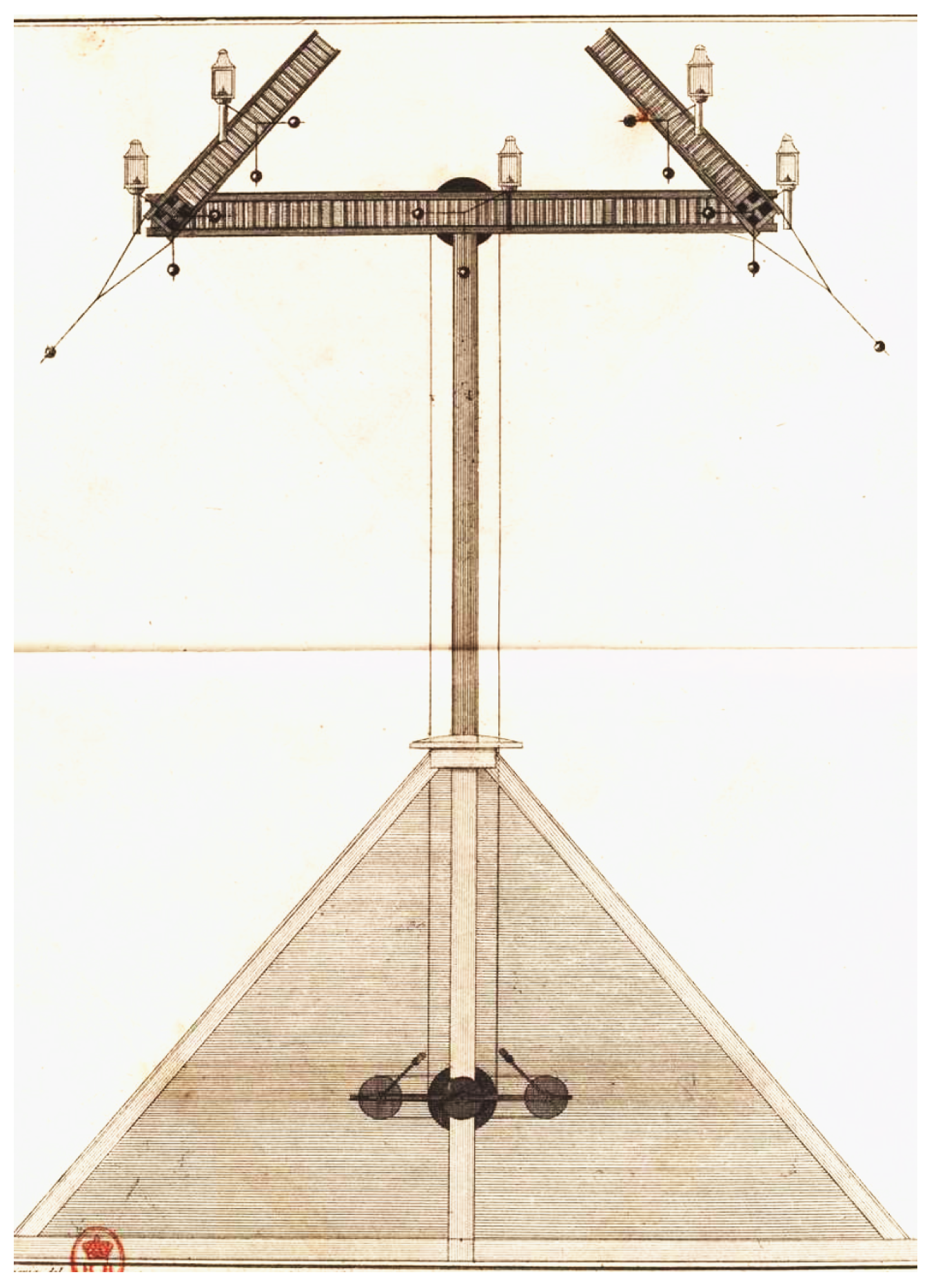
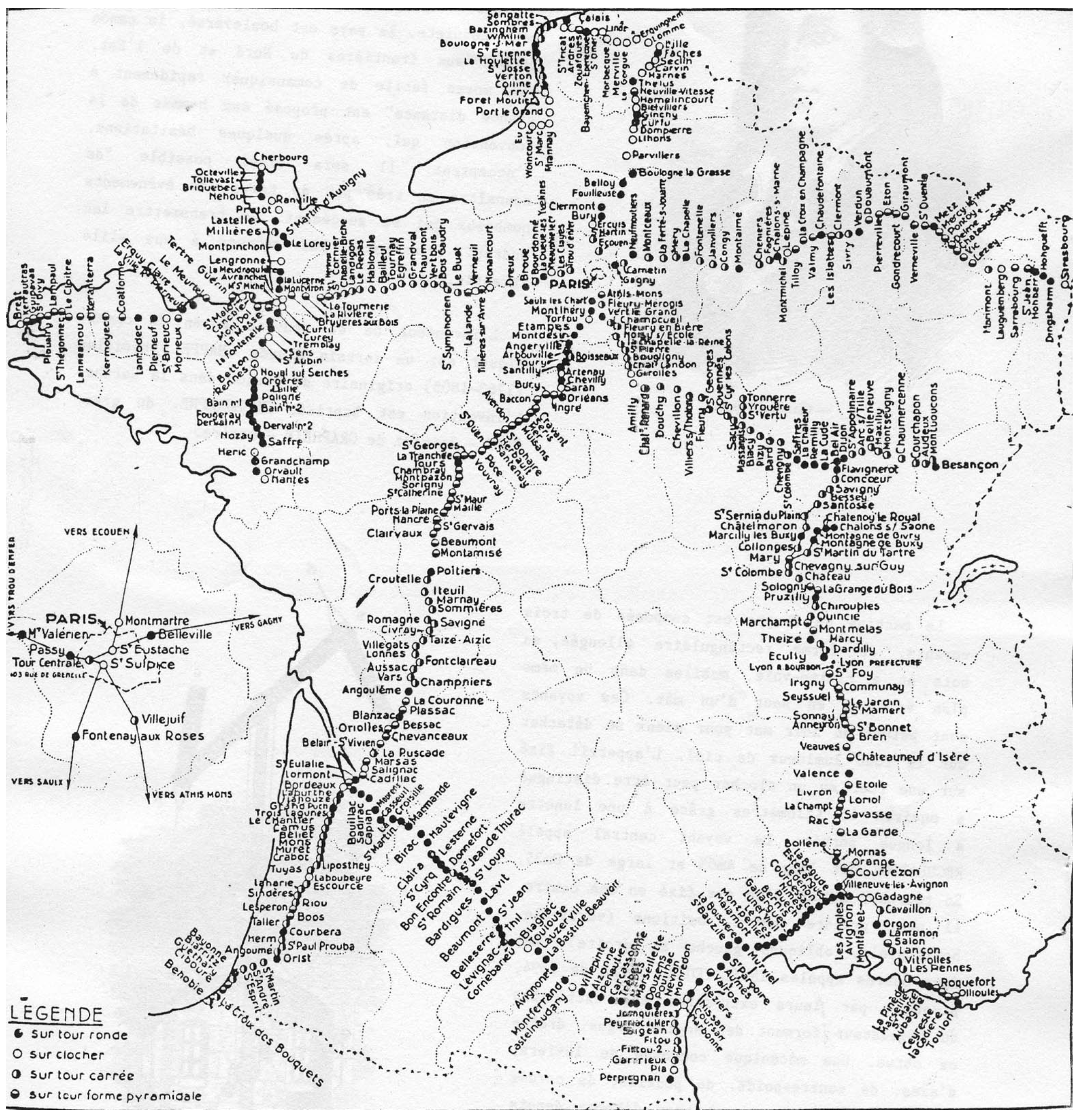

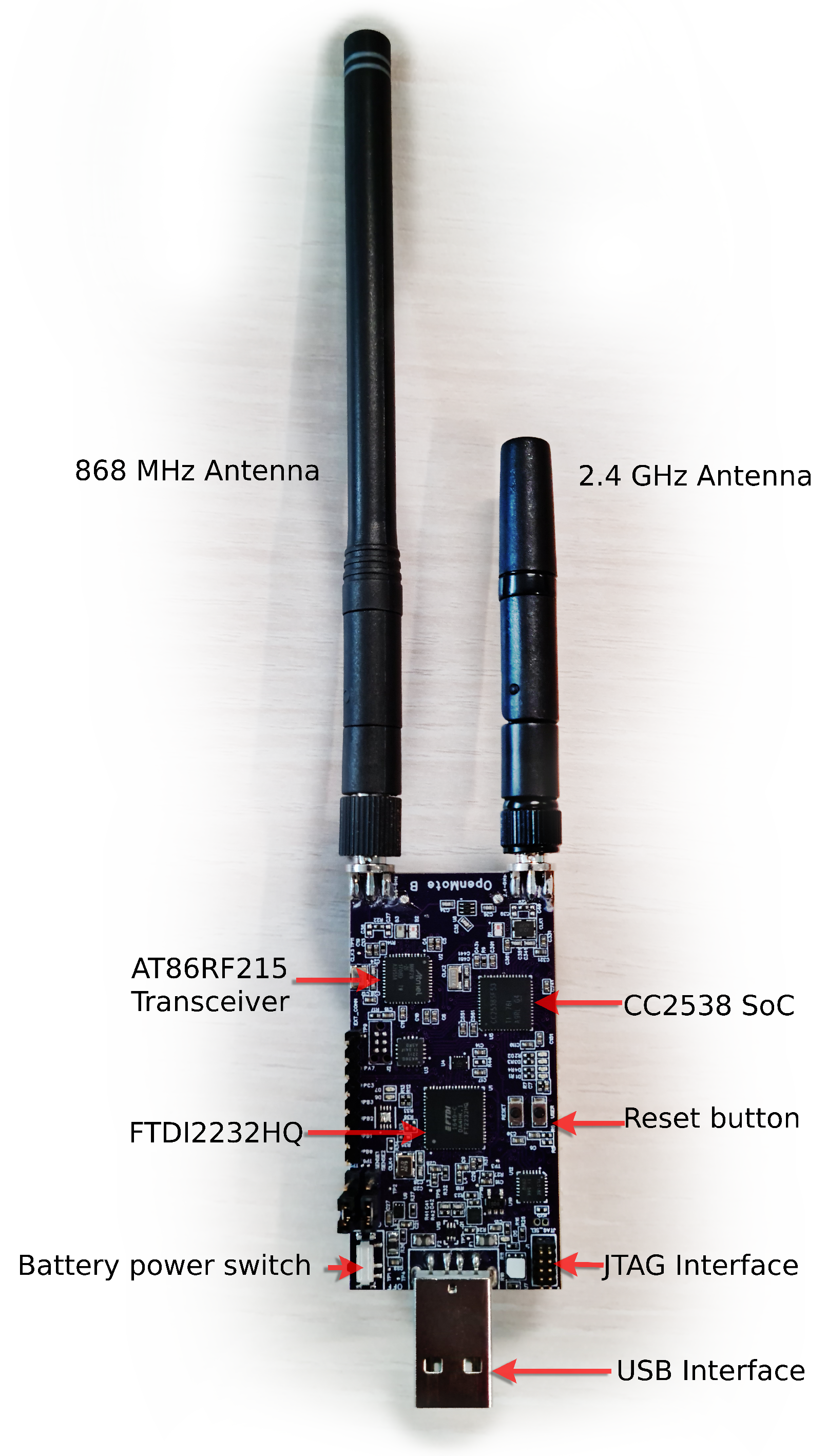

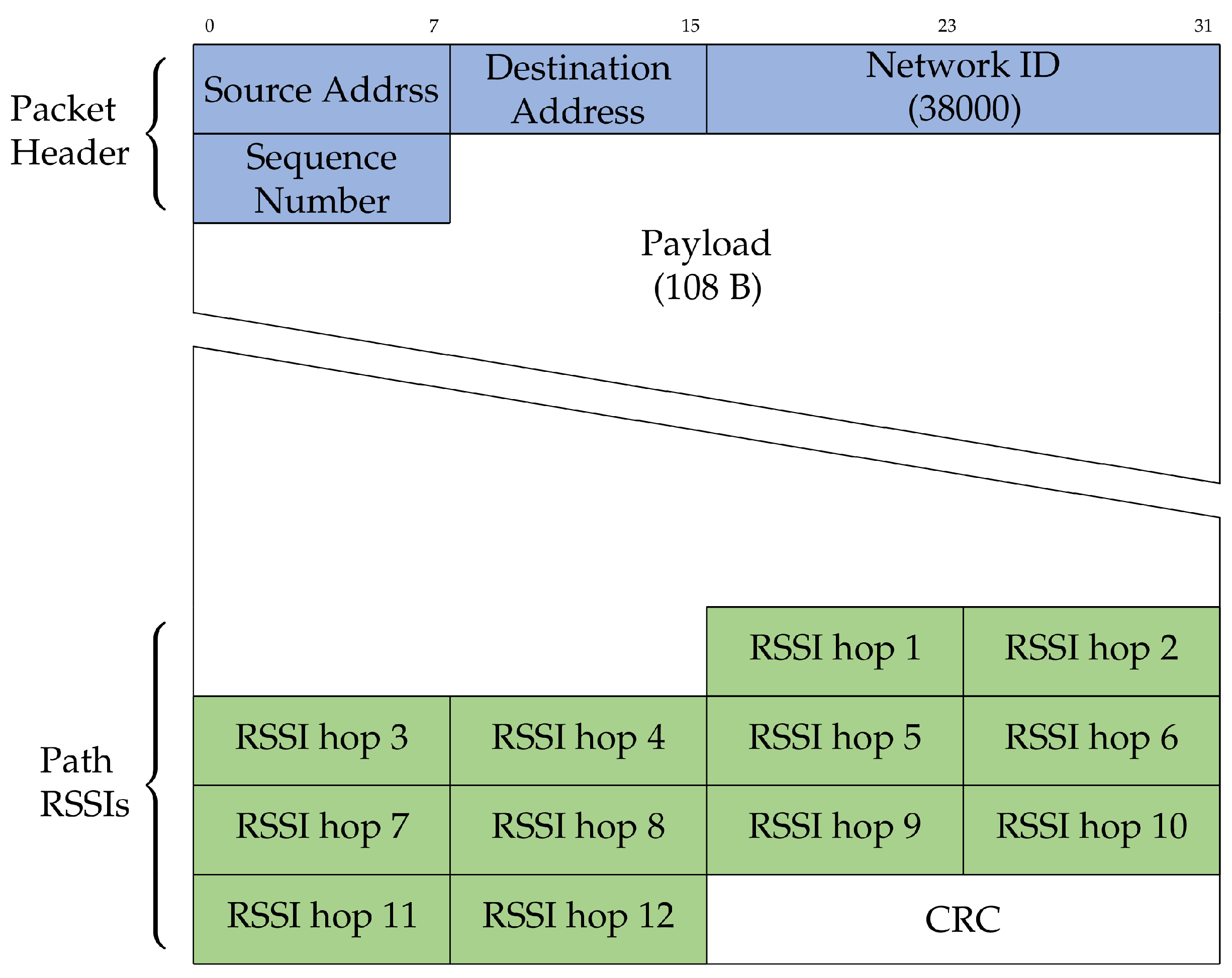



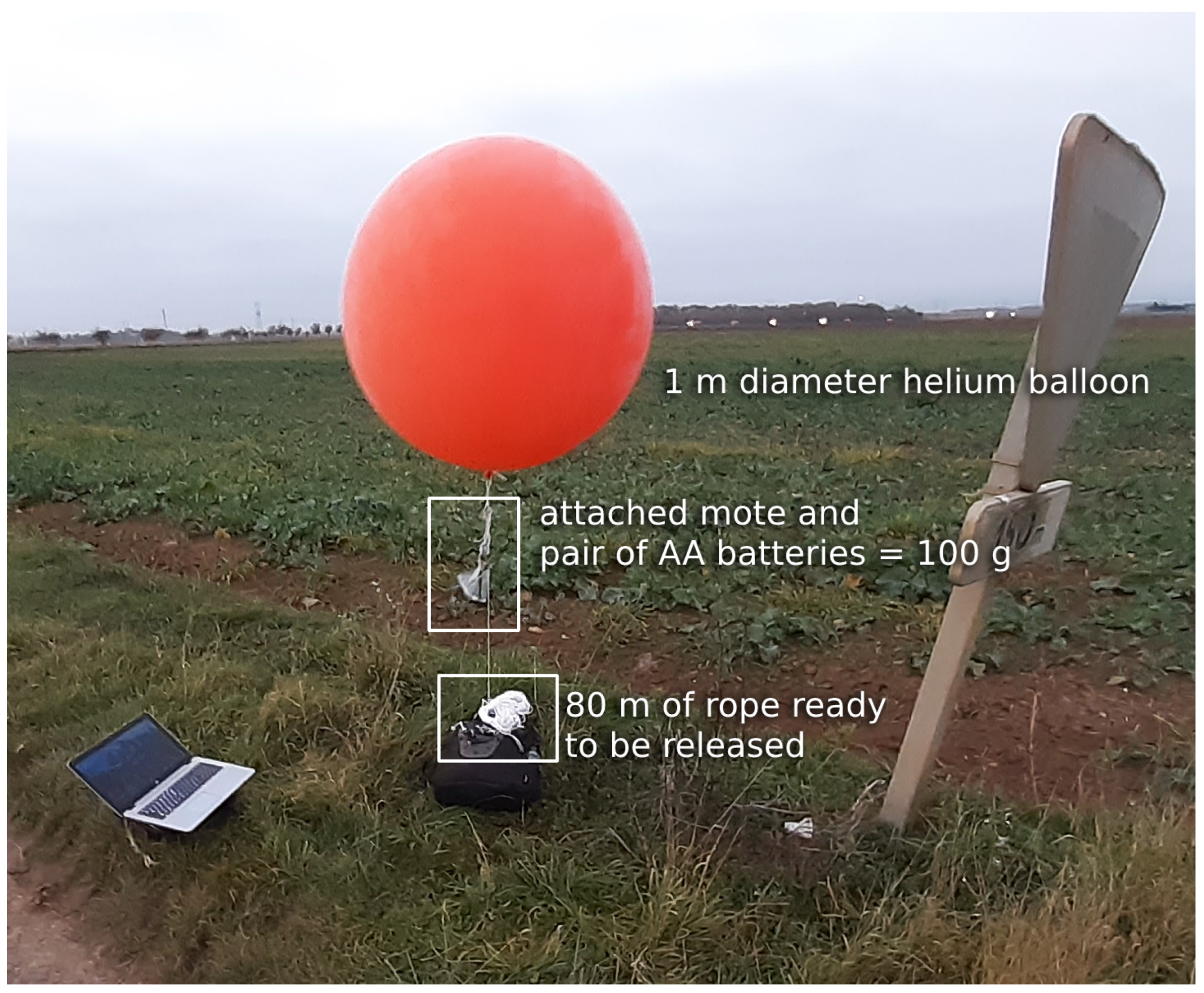

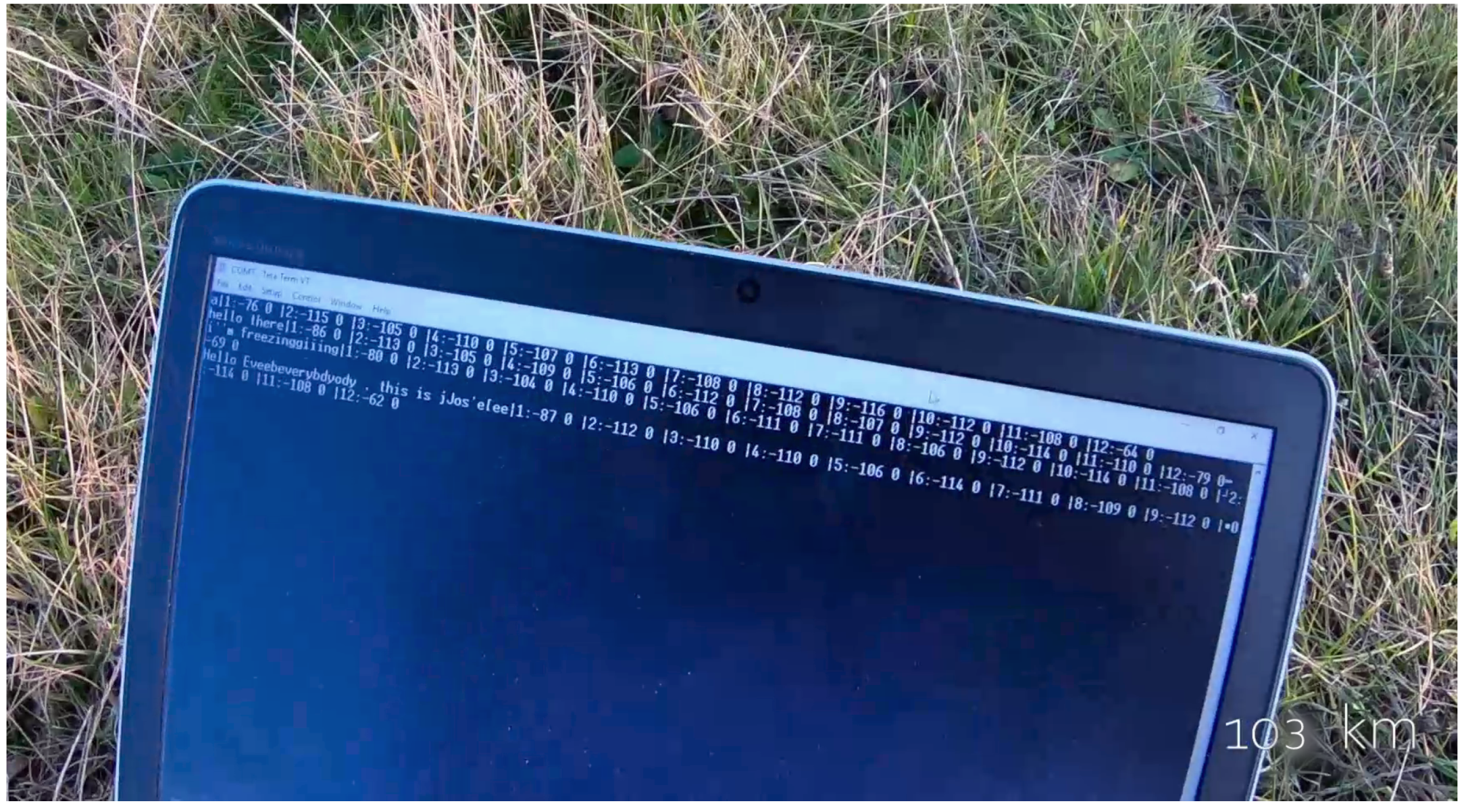
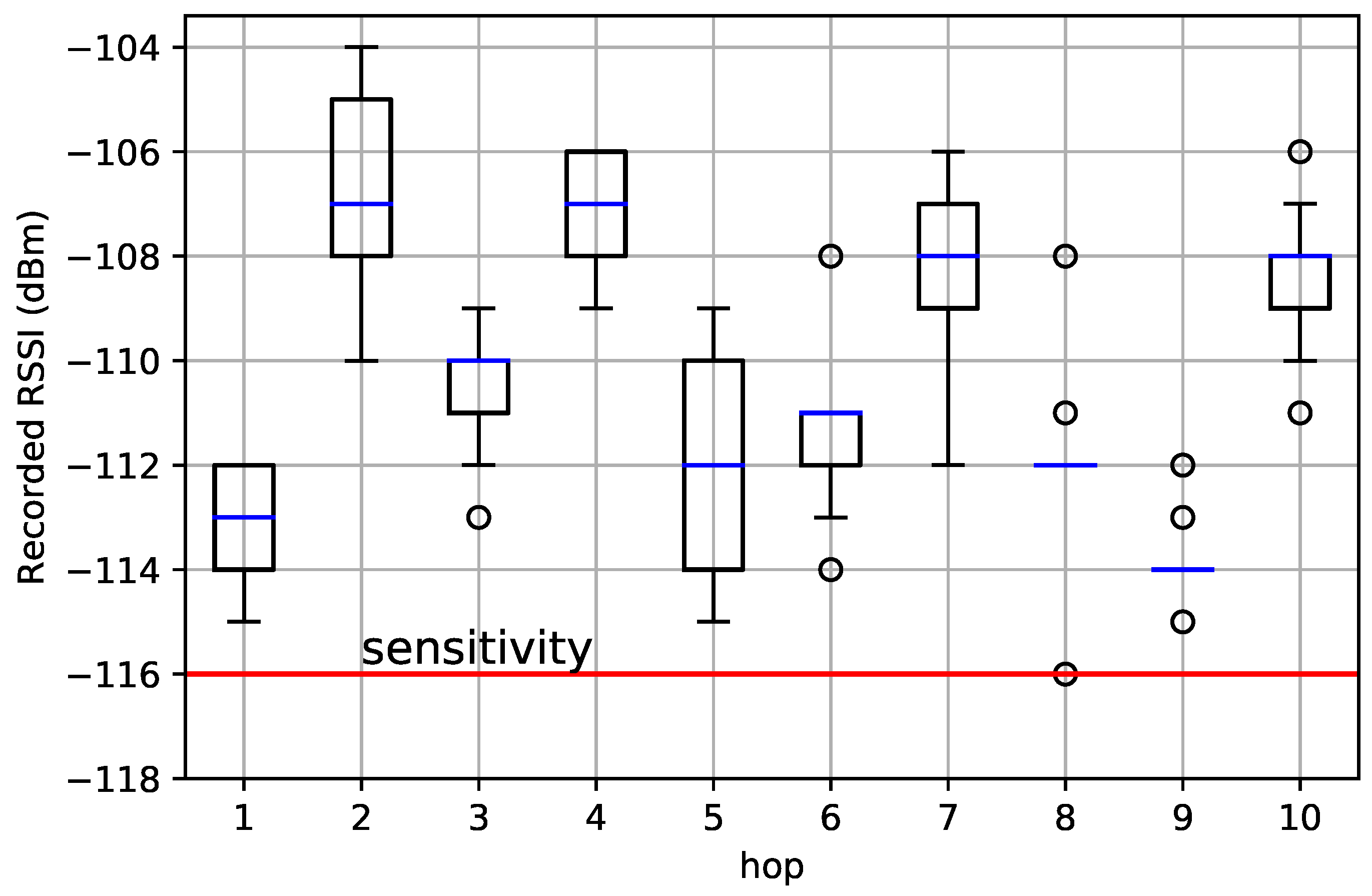
| Hop | Distance | Fresnel Clearance | |
|---|---|---|---|
| 1 | Torfou–Etampes | 10.48 km | 30.1 m |
| 2 | Etampes–Angerville | 8.97 km | 27.9 m |
| 3 | Angerville–Arbouville | 12.67 km | 33.1 m |
| 4 | Arbouville–Toury | 10.25 km | 29.7 m |
| 5 | Toury–Artenay | 11.86 km | 32.0 m |
| 6 | Artenay–Chevilly | 8.74 km | 27.5 m |
| 7 | Chevilly–Bucy | 10.69 km | 30.4 m |
| 8 | Bucy–Baccon | 11.57 km | 31.6 m |
| 9 | Baccon–Cravant | 7.93 km | 26.2 m |
| 10 | Cravant–Séris | 9.97 km | 29.3 m |
| total distance | 103.13 km | ||
Publisher’s Note: MDPI stays neutral with regard to jurisdictional claims in published maps and institutional affiliations. |
© 2022 by the authors. Licensee MDPI, Basel, Switzerland. This article is an open access article distributed under the terms and conditions of the Creative Commons Attribution (CC BY) license (https://creativecommons.org/licenses/by/4.0/).
Share and Cite
Rady, M.; Muñoz, J.; Abu-Aisheh, R.; Vučinić, M.; Astorga Tobar, J.; Cortes, A.; Lampin, Q.; Barthel, D.; Watteyne, T. A Historical Twist on Long-Range Wireless: Building a 103 km Multi-Hop Network Replicating Claude Chappe’s Telegraph. Sensors 2022, 22, 7586. https://doi.org/10.3390/s22197586
Rady M, Muñoz J, Abu-Aisheh R, Vučinić M, Astorga Tobar J, Cortes A, Lampin Q, Barthel D, Watteyne T. A Historical Twist on Long-Range Wireless: Building a 103 km Multi-Hop Network Replicating Claude Chappe’s Telegraph. Sensors. 2022; 22(19):7586. https://doi.org/10.3390/s22197586
Chicago/Turabian StyleRady, Mina, Jonathan Muñoz, Razanne Abu-Aisheh, Mališa Vučinić, José Astorga Tobar, Alfonso Cortes, Quentin Lampin, Dominique Barthel, and Thomas Watteyne. 2022. "A Historical Twist on Long-Range Wireless: Building a 103 km Multi-Hop Network Replicating Claude Chappe’s Telegraph" Sensors 22, no. 19: 7586. https://doi.org/10.3390/s22197586
APA StyleRady, M., Muñoz, J., Abu-Aisheh, R., Vučinić, M., Astorga Tobar, J., Cortes, A., Lampin, Q., Barthel, D., & Watteyne, T. (2022). A Historical Twist on Long-Range Wireless: Building a 103 km Multi-Hop Network Replicating Claude Chappe’s Telegraph. Sensors, 22(19), 7586. https://doi.org/10.3390/s22197586






